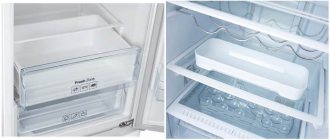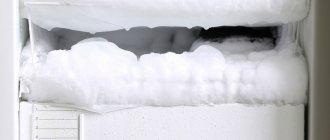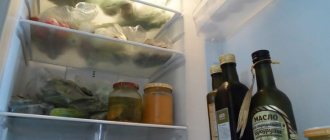How often should you defrost your LG No Frost refrigerator?
Many users are interested in how often they need to defrost a No Frost refrigerator. It is recommended to unplug the device and clean the compartments every 6-12 months. The frequency of defrosting depends on the design features of the refrigeration unit. The indicator is calculated based on the device testing results. The parameter is indicated in the technical data sheet of the product.
You should also pay attention to the presence of ice. When a thick ice crust forms, the circulation of the refrigerant is disrupted. The compressor begins to work continuously, which leads to rapid wear of some parts of the device. When ice appears, you should not wait the required 6 months. You need to defrost the No Frost refrigerator immediately.
Refrigerator Stinol RF 345 A
Refrigerator Stinol RF 345 A 008 is a brand of refrigerator where the refrigerating chamber is equipped with a “drip” evaporator, here defrosting occurs automatically. When the compressor turns off, the frost on the surface of the evaporator melts. And then it flows in drops through the drain hole into the condensate tray. There is no No Frost system in this refrigerator. The freezer compartment is defrosted manually. The refrigerator compartment can be cleaned and washed once a year, as it gets dirty.
The video shows all the details of defrosting and washing the refrigerator:
General defrosting and cleaning of the refrigerator.
How to properly defrost an LG No Frost refrigerator
Any refrigerator needs care. To do this, it is defrosted and washed.
Important! If the compartments of the refrigerator are not washed, bacteria will begin to multiply intensively in it, which will lead to rapid spoilage of food. Disconnecting the device from the power supply must last for at least 12 hours. During this time, the refrigerant pressure in the system gradually decreases. Turning on the unit prematurely will result in compressor failure and costly repairs.
Preparatory stage:
- The temperature regulator in the device is set to zero;
- disconnected from the network;
- a rag is placed next to the door;
- disconnect equipment from the power supply;
- remove all food from the refrigerator;
- remove shelves, drawers, pallets, grates - all elements that can be detached are best washed separately;
- leave the freezer open and wait for the ice to disappear;
- accumulated water is collected with a sponge.
To assess the thickness of the ice layer, you can remove the back wall of the freezer. If it is thick, this indicates either improper operation of the device or a malfunction in its operation.
Defrosting procedure:
- Defrosting and cleaning equipment should not be carried out in too hot or too cold weather. External temperature maximums and minimums are an unnecessary and unnecessary test for a refrigeration compressor.
- If the equipment has two cooling circuits, only one of the chambers can be defrosted. If the refrigerator has one cooling circuit (which happens more often), i.e. It is not possible to turn off only one of the cameras and leave the other running; it must be disconnected from the power supply. Remove all food from the refrigerator and leave the doors wide open.
- The entire refrigerator needs to be washed, so it is advisable to move it away from the wall and kitchen unit so that you can clean not only the internal chambers, but also the external panels, including the back wall, where the most dust accumulates. Pay special attention to the handles and other parts of the surface of the device that are most often touched by your hands.
- You can speed up the thawing process and bring the temperature inside the refrigerator to room temperature, and at the same time dry the wet areas of the internal walls of the device, using a regular hair dryer. If you don’t have a hairdryer, you just need to leave the refrigerator open for an hour and a half. Under no circumstances try to scrape frost and ice from the walls of the appliance with knives or spatulas! This way you will probably damage your equipment.
- When the device has completely cooled down, you can proceed directly to cleaning it of dirt. It is important to remember that you should absolutely not use any chemicals to clean the internal chambers of the refrigerator! Refrigeration equipment stores food, and you do not want chemical particles harmful to human health to subsequently settle on it.
- Since the ventilation system is an important part of the No Frost technology, the first thing you should pay attention to is the ventilation openings in the refrigerator and freezer compartments. Take regular cotton swabs, soak them in clean warm water or a mild soda solution and carefully apply each hole. Under no circumstances remove or unscrew the panels covering the ventilation! This is a violation of the warranty agreement, which means that in the event of a breakdown, you will be denied free repairs. This may violate the terms of the warranty agreement between you and the manufacturer. For external panels, you can use regular cleaning products, with the exception of powders, which may cause scratches.
- After the ventilation mesh is clean, you can begin to work on glass shelves, door pockets, pull-out containers for vegetables and fruits, and other elements of the interior of the refrigerator. You need to use the same aqueous solution of regular table soda. Particular attention should be paid to the rubber seals that ensure the refrigerator doors close tightly. Rubber is an excellent breeding ground for bacteria and germs, so regularly wiping it with detergent is a must.
- After treating all the internal surfaces of the refrigeration device with a soda solution, you should go over them again with a regular damp cloth dipped in warm water. Then they need to be wiped dry with a soft cloth so that there are no streaks or water stains left. The doors of the device can be left open for some more time so that the refrigerator chambers dry completely.
- Now your refrigerator is clean and you can return all the shelves and containers to their place, close the doors and move the device back to the wall. Unlike classic refrigeration equipment, No Frost refrigerators gain cold faster, so food can be placed on the shelves immediately after it is plugged in.
Defrosting a windy type LG No Frost refrigerator
Defrosting is carried out as follows: an evaporator is installed behind the rear walls of the chambers, onto which cooled air enters. The air flow direction is controlled by a built-in fan. The ice in such a system is able to thaw on its own, so defrosting a two-chamber Bosch unit takes less time. If there is no need for cleaning, you can defrost a No Frost refrigerator of this type without removing food. However, it is recommended to clean the ventilation grilles as often as possible.
Defrosting a drip-type refrigerator LG No Frost
The operating principle of drip defrosting involves the operation of an evaporator mounted on the wall of the refrigerator compartment. When the compressor operates, frost accumulates on this part. When the engine is turned off, the ice begins to thaw. The resulting liquid is discharged through gutters into a container located outside the chamber. Here the water turns into steam. When the holes in the evaporator area become clogged, frost accumulates, causing refrigerators to take a long time to defrost. When cleaning the main compartment, you need to properly clean the water drainage gutters.
Ways to speed up
You can speed up freezing using proven “folk” methods:
- turn on the fan or fan heater, directing a stream of air into the chamber;
- place a wide saucepan or bowl of hot water in the chamber;
- use a hand-held hair dryer;
- place several heating pads or bottles filled with hot water in the chambers;
- Spray the inside walls of the refrigerator with a spray bottle of hot water.
But LG refrigerator manufacturers recommend not to experiment, but to wait for the natural thawing of frost. This way you will keep your device intact and will be able to enjoy its uninterrupted operation for a long time.
Do you speed up the defrosting of your refrigerator?
Not really
About
How to properly clean an LG No Frost refrigerator after defrosting
Cleaning up the inside of the LG No Frost refrigerator
- When cleaning a household appliance, start by cleaning its internal parts, moving from top to bottom and paying special attention to the corners of the chambers;
- do not forget to wash and disinfect the drain hole on the back wall of the refrigerator compartment: clean it with a brush, then draw detergent into a syringe (without a needle) and pour it into the channel;
- clean the holes on the fan grille with cotton swabs soaked in cleaning product;
- wash the outer parts of the case, wipe the condenser located on the back wall with a slightly damp sponge;
- Wash the sponge or rag from any remaining cleaning products, fill a bowl with water and rinse all surfaces with it;
- take a dry towel and wipe the refrigerator inside and out;
- leave the device with the door open so that all moisture from the internal surfaces completely evaporates;
- Reinstall the shelves and drawers in their original place, plug in the device and after half an hour place the food in it.
IMPORTANT! According to the recommendations of manufacturers of refrigerators with a no-frost system, such units can only be connected to the network 12 hours after being turned off.
LG No Frost refrigerator cleaning products
To wash your refrigerator, you can use both chemicals and homemade products.
Dish detergent:
- pour hot water into a bowl, add a couple of teaspoons of washing gel to it, mix the ingredients until foam forms;
- soak a soft sponge in the solution, wipe all elements previously removed from the device (shelves, grilles, drawers) and the internal and external surfaces of the refrigerator;
- After removing dirt, be sure to rinse off any remaining cleaning product with water.
Other chemicals in the form of various sprays, liquids, foam, wet wipes (Top House, Silit Bang, Horse) are also suitable for cleaning the refrigerator.
In addition to excellent cleaning properties, which allow housewives to get rid of contaminants in the device in a short time, most of these products also have disinfecting abilities.
IMPORTANT! When working with special preparations, do not forget to wear rubber gloves. After cleaning surfaces, be sure to wipe them with a cloth dampened in clean water.
Traditional methods will also help you rid your refrigerator of stains of various origins:
- make a soda solution from 2 tablespoons of powder and 1 liter of water, treat the inner walls of the chambers with it, rinse the surfaces with water;
- grate half a bar of laundry soap, mix the shavings with warm water. Use the product to remove dirt from problem areas;
- dampen the sponge in hydrogen peroxide (3%) and wash the chambers.
The sealing tape on the door of the device can also be cleaned with dishwashing detergent and hydrogen peroxide.
The use of vinegar, soda to remove mold or grease from a rubber element is unacceptable, since these substances can damage the part and break the seal of the chambers.
If you notice that the tape has lost its elasticity, apply a little olive oil to a rag and rub it into the seal.
IMPORTANT! To clean the refrigerator, do not use aggressive chemicals (containing chlorine, concentrated acids, alkalis) or abrasives. Treat the surfaces of electrical appliances only with soft cloths or sponges.
Getting rid of unpleasant odors in the LG No Frost refrigerator
The appearance of unpleasant odors in the device is most often associated with improper storage of products (failure to comply with product rules, storage of spoiled food, etc.).
To get rid of the “aroma,” first of all, find out and eliminate the cause of its occurrence.
The following methods will help eliminate strong odors from the refrigerator:
- mix vinegar and water in equal proportions and wash the inner walls of the chamber;
- crush 20-30 tablets of activated carbon, pour it onto plates or into gauze bags, place the product inside the refrigerator;
- crushed citrus peels (lemon, orange), black tea, sugar, rice, vanilla, coffee beans (grind them first) “absorb” various aromas well: as in previous cases, place the products in bags made of linen fabric, gauze, put inside a household devices.
Special balls for refrigerators, which are sold in household chemical stores, effectively eliminate even the most pungent odor.
The mineral components they contain destroy the unpleasant “amber” and prevent the appearance of mold. The balls are effective for 3-4 months; after this period, the drugs should be replaced with new ones.
ADVICE! Don't forget to take care of the device if you need to leave for a long time: defrost, wash the device and leave it unplugged, with the door open.
Carry out periodic checks of the products in the unit, throw away food that has expired, store food in special containers closed with a lid.
Cleanliness in the refrigerator is not only the key to your health, but also to the long life of your kitchen appliances.
General recommendations
The main thing in defrosting a refrigerator is not just to free it from frost, but to defrost it so that the process does not harm the device. Follow these recommendations:
- Carefully read the instructions for the device. All operating rules, including defrosting, must be indicated there.
- Do not defrost in hot weather. A large temperature difference between the outside and inside the chamber can be an overwhelming test for the compressor.
- Connect the device to the network no earlier than 12 hours after disconnecting. When turned off, the refrigerator condenser takes time to release pressure. If, after turning off the refrigerator, you immediately turn it on, the pressure will rise sharply, the engine will receive too much load and may fail.
If you are the happy owner of a two-chamber LG refrigerator, you can defrost the parts independently. First, unplug and wash the freezer, and then clean the refrigerator.
What is No Frost in LG refrigerators
No Frost is a cooling system for the freezer and refrigerator compartments, which provides forced circulation of cold air and prevents the formation of ice on the walls of the refrigerator; it replaces the classic drip method.
Modern models are so advanced that they require virtually no care and maintenance. Just a few decades ago, women spent at least half of their day off each month performing a sacred act called defrosting the refrigerator. Today, many young housewives are not at all familiar with this concept. This has become possible thanks to new developments in the field of cooling systems.
Modern units use two fundamentally different cooling technologies: drip and No Frost. The first is much more common and is already well known. But about the second, many questions still arise.
If you believe the promises of manufacturers, No Frost system refrigerators do not need defrosting at all. The fact is that frost on the walls of the refrigerator occurs due to increased humidity inside the chamber. Droplets of water freeze and eventually turn into an ice crust.
Refrigerators with the No Frost system operate without the formation of frost and ice. By the way, the very name of the technology speaks about this. “No frost” literally means “without frost/frost.” This effect is achieved by including several fans in the system. Streams of cold air blow across the inner walls of the chamber and dry droplets of formed moisture. Thus, practically no frost forms on the walls, which means there is simply nowhere for the snow cap to come from.
In refrigerators equipped with No Frost technology, the evaporator is placed outside the chamber and is forced to be blown using one or more coolers. Frost still forms in such units, but not in the chamber, but on the tubes and fins of the cooling system. From time to time, a special heater turns on, which independently defrosts the system. The liquid collects in a pan hidden behind the compressor and the process begins all over again.
Although dry freeze refrigerators were specifically designed for use in countries with fairly humid climates, they are also widely used in our region.
How the No Frost system works in an LG refrigerator
Like the classic version of the drip cooling system, the No Frost technology works on the principle of condensation and has been modified by adding a new element - a ventilation system. Cooling is carried out according to the following principle:
- Cold air is produced using an evaporator located behind the back wall of the refrigerator or freezer.
- Several additional fans are built into the design, which blow through the evaporator and thereby evenly distribute cold air throughout the chamber.
- The resulting moisture settles back on the evaporators, which is a natural physical process.
- The resulting frost is removed from the refrigerator wall by briefly activating a special heater, which facilitates automatic defrosting.
- The moisture evaporates on its own from a special tank, which completely automates the operation of the refrigerator.
Video: how the No Frost system works
Watch this video on YouTube
Advantages and disadvantages of the No Frost system in the LG refrigerator
Advantages of modern defrosting technology:
- No constant care is needed, whereas classic models require manual defrosting several times a month.
- The temperature in all compartments is approximately the same. The only exceptions are specially programmed zones.
- Thanks to regular automatic defrosting, condensation does not remain on the walls of the internal chambers.
- Forced air circulation in the chamber ensures rapid cooling of products.
- The optimal temperature regime is quickly restored after opening/closing the door.
- Many models have a dry freezing option. This technology preserves the beneficial properties of products.
- Using fans to provide better circulation of cooled air allows you to quickly set the desired temperature, which makes the Quick Freeze function available for use.
- Rapid removal of frost and improved condensation reduces the humidity level in the refrigerator compartment by 2 times, which creates favorable conditions for storing food and slows down the growth of bacteria.
- There is no need to manually defrost the refrigerator and freezer compartments, which creates comfortable conditions for using the device and saves personal time.
But there are also disadvantages:
- Due to the built-in fans that supply cold air to the chamber, the actual internal volume of such models is somewhat smaller than it might seem at first glance.
- For the same reason, No Frost consumes slightly more electricity than their drip comrades.
- It is slightly noisier. However, the most modern models are equipped with an enhanced sound insulation system, so that the increased number of decibels is almost imperceptible.
- The air circulating in the No Frost refrigerator chamber dries not only the walls, but also the food. To prevent this effect, products should be packaged in plastic containers or wrapped in cling film.
- Probably the biggest disadvantage of such refrigerators is the price, which is slightly higher than that of their drip counterparts.
Do you want to understand better than others?
- Is it possible to defrost a freezer with a hairdryer - Perhaps this method is the most popular, you need to turn it on to the warm blowing mode and bring it to the ice. Despite many questions, this method can and should be used for...
- What you need to know about the Low Frost system - When buying a modern refrigerator, many do not understand what the term Low Frost means, indicated in the characteristics of the freezer. This type of defrosting technology was...
- Built-in refrigerators from the manufacturer AEG with No Frost: characteristics of the models - German appliances for any purpose, including household ones, are highly valued all over the world. High-tech refrigeration equipment is the main principle of the AEG brand, which was...
- Why do you dream of an empty refrigerator filled with food? - It is impossible to imagine any home without a refrigerator. From this article you will know why he dreams. For what reasons does a person see empty or filled...
- Top 3 best two-chamber Pozis refrigerators with No Frost system: detailed review - No Frost is a system designed to prevent the formation of ice and frost. Full no frost implies that this type of work applies to both refrigeration and…
Where to store food?
During winter defrosting, the problem of preserving food is easy to solve - provisions are taken out to the balcony, loggia or veranda, where the temperature remains low . In summer, it is better to try to defrost at a time when there is a minimum amount of food in the refrigerator.
Frozen meat and semi-finished products are well preserved in an enamel basin, covered with a thick towel or padding polyester blanket. The basin is placed in the bathroom or room where the temperature is lowest.
A good solution is to use a spacious cooler bag. Perishable, non-frozen foods can be placed here. Another option is to place the provisions in sealed plastic bags and submerge them in a bathtub of cold water and ice.
Defrosting process No Frost
Before you start defrosting the unit, you must turn it off. Food residues that accumulate on shelves cause unpleasant odors. By cleaning and defrosting the switched-off appliance, functions are updated and the overall performance of the equipment is improved.
Recommendations for defrosting
Almost all refrigeration units have standard defrosting instructions. Let's list the main points:
- For safety and “reboot” purposes, before defrosting, the refrigerator is first disconnected from the network.
- Shelves, containers and chambers are cleared of products. An empty refrigerator is much easier to clean and defrost.
- To clean the surface, use a solution prepared on the basis of 2-3 tbsp. soda and half a liter of water. It is not recommended to clean the internal surface of the equipment with any kind of household chemicals containing substances that are difficult to remove even after thorough wiping. They poison food and cause intoxication of the body or allergies. Products saturated with chemical components are considered unfit for food and have a specific odor.
- Shelves, walls, ventilation panels and drains are thoroughly cleaned and wiped dry. Hard-to-reach areas can be reached using a cotton swab.
Shelves, walls, pockets, rubber seals, containers and other containers are wiped with a soft sponge soaked in soda solution, rinsed clean and wiped with a towel to remove residual water from the refrigerator compartment.
As a rule, the turned off refrigerator is left to defrost for 2 to 24 hours. The defrosting speed depends on the unit model and is set by the manufacturer.
After completing the defrosting procedure and cleaning the chamber, turn on the refrigerator and let it run idle for at least 1 hour to reach the required temperature for storing food.
Defrost frequency
Refrigeration units produced decades ago did not have an automatic defrost function. Therefore, equipment owners were forced to periodically turn off and defrost the camera. New improved models are able to work for a long time without defrosting. During operation, dirt accumulates on the walls, which leads to a decrease in equipment performance. Energy costs are seriously increasing. It is recommended to defrost appliances with an automatic defrosting system at least once every 6 months.
If you try to follow all the recommendations mentioned, the refrigerator will work for a long time. When purchasing any household appliance, you must carefully study the instruction manual.











